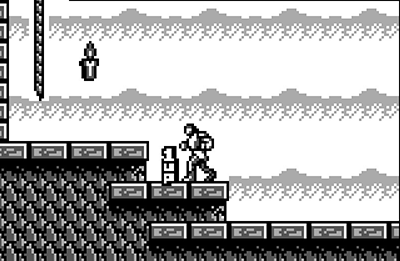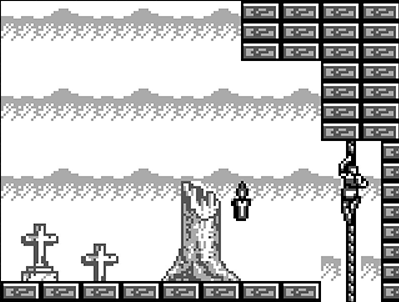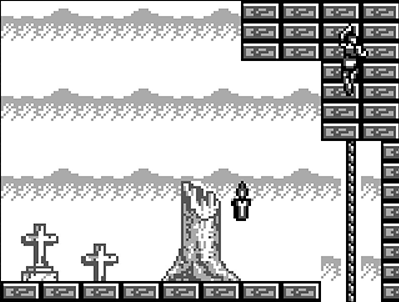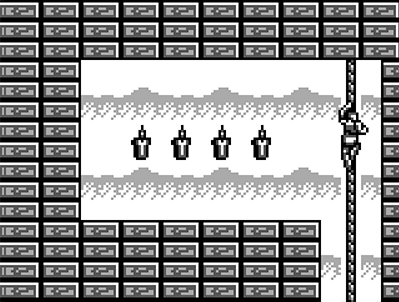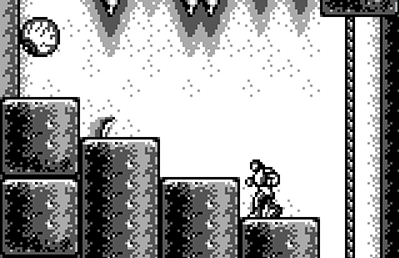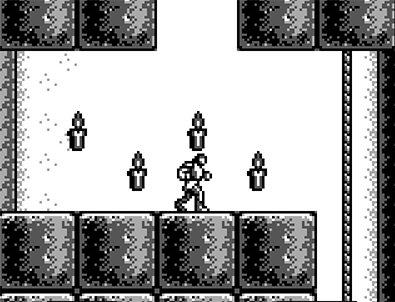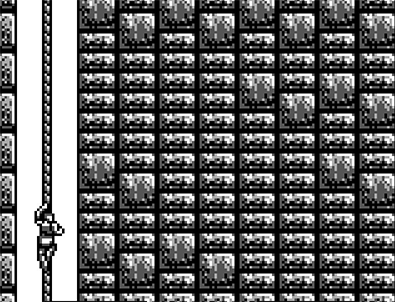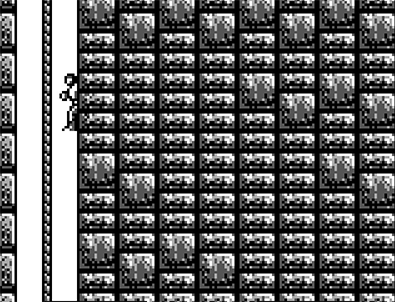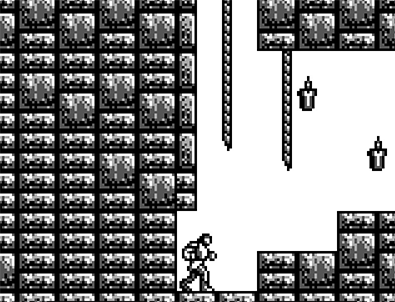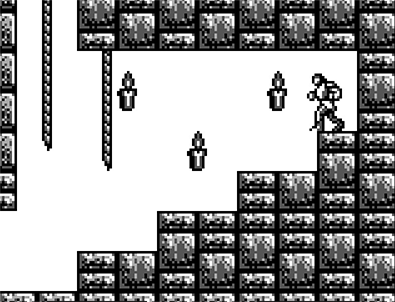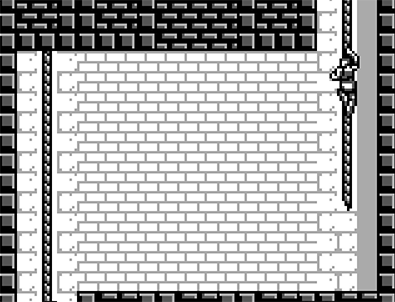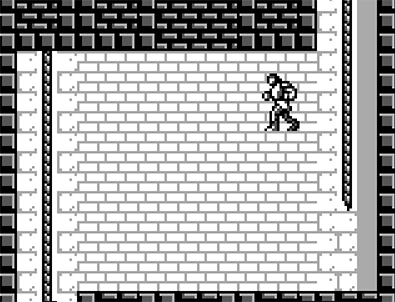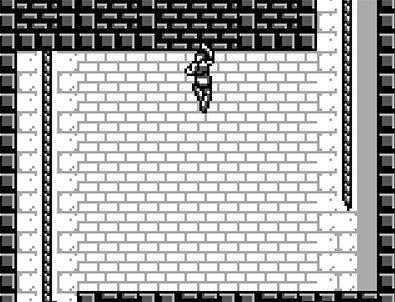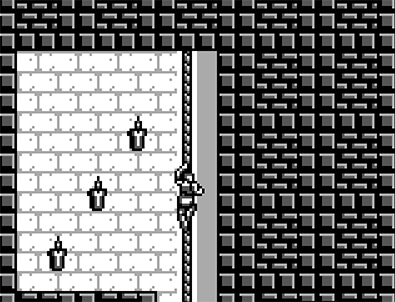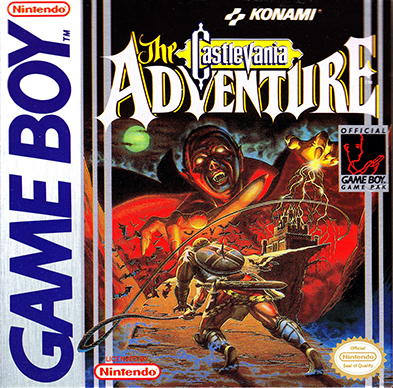
Castlevania: The Adventure
- Konami, 1989 -
SCORE: 42 out of 100
PLAY AT YOUR OWN DISCRETION! Konami's introduction on Nintendo's Game Boy that translates as a frustratingly-slow, punishingly-hard, portable experience that brought a few, fresh ideas to the Castlevania franchise, despite hardware and programming limitations.
[REVIEW|+ VS. -|IF YOU LIKE...|SECRETS & TIPS|FINAL SCORE|BREAKDOWN|MISCELLANEA]
The (Mis)Adventure
After two releases on the NES, Konami's horror, action/adventure series—Castlevania—was firmly establishing its status as a classic. But, how would it be received as a standalone, pick-up-and-go title for the new, portable Nintendo Game Boy? Would this adventure be another hit or a near miss?
In the late 1980s, scores of fans assisted one, Simon Belmont, in triumphantly extinguishing the evil, everliving Count Dracula—not once, but twice—on the equally-resilient, home video gaming console that resuscitated the once flagging industry from the ill-fated video game crash of 1983: the Nintendo Entertainment System (NES).
Certainly, the series' parent company, Konami, would revive its lucrative, legendary tale for a third time. It would—but there would be a caveat: the next game would not be number three in a trilogy, nor would it even be released on the NES!
This new installment of Castlevania would side-step and step out (some might say misstep [More about that later.]) into the newest venture that Nintendo was directing its interests. Conceived by inventive mastermind, Gunpei Yokoi, the Game Boy was Nintendo's attempt at capturing some of the magic of its wildly-successful NES and gifting gamers the ability to play on-the-go.
One of the best features of this new, portable device was its ability to swap in and out different game cartridges, just like the NES—a highlight that made this handheld especially enticing and outstanding from its fellow, LCD (Liquid Crystal Display) screen competitors of the day.
The timing of the Game Boy's release in North America created a unique opportunity for Konami. Being in-between releases for its famed Castlevania franchise, it was able to jump in near the new console's launch to be the first, non-Nintendo produced license to appear.
(Note that the development team tapped for Castlevania: The Adventure was completely different from that of Castlevania III: Dracula's Curse, which would release and return—as a direct prequel of the original series—only a year later in 1990 on the NES in the North American region once again.
However, it is very interesting to cite that Castlevania III: Dracula's Curse was actually released only one week later in the Japanese market (on December 22, 1989) than Castlevania: The Adventure was in the North American market!)
How would this unique Castlevania experience delivered on a new platform fare? Let's take a deeper look.
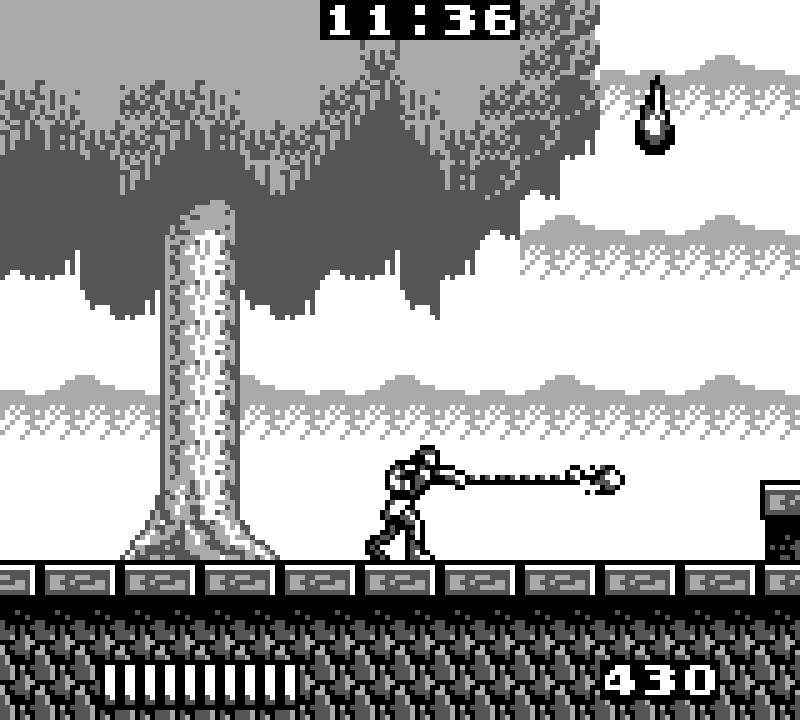 "It's raining [Mud]men!" No, actually... the manual calls this dripping foe, Madman. Whatever the name, Konami's picturesque art is on full-display... even in four colors! Also of note: the introduction of powered-up whips shooting fireballs would be used in some future titles.
"It's raining [Mud]men!" No, actually... the manual calls this dripping foe, Madman. Whatever the name, Konami's picturesque art is on full-display... even in four colors! Also of note: the introduction of powered-up whips shooting fireballs would be used in some future titles.With the project green-lit, Konami and its team were eager to embark on this adventure... this Castlevania adventure, if you will.
Set in what the instruction manual, cryptically, describes as "the misty midst of Dracula's less than welcoming lair", little background is provided about the plot. In fact, nowhere in game or in the manual is our hero even given a name! (An inauspicious omen of things to come with more things gone wrong coming shortly.)
At first glance, any long-time fan of the series will be drawn in by a false sense of familiarity for the opening look and feel of Stage 1.
That mastery of music, of Castlevanian synth sounds setting the Gothic, horror-lite tone ahead... That distinct touch of Konami's talented graphic artists and background designers is present, as your Belmont (???) stands at the ready, amidst a forested scene with candles—albeit in pared-down, 2-Bit color scheme.
The Game Boy's smaller capacity for data, processing and actual resolution (only 160 × 144 pixels in four shades of green/gray, dot matrix display) would mean that other things—besides just the light story, a threadbare tale of Dracula seeking revenge—may have to be sacrificed or truncated in less-than-ideal ways, too.
This becomes painfully apparent as soon as you start the game and use the Game Boy's patented directional pad to move your character. The suspiciously-high countdown time-stamped at the top of the screen (beginning at 13:15!) suddenly makes sense.
Simon Belmont was never the fleetest of foot, but his "speed" feels like sprinter-class, next to the surprisingly-slow gait and stalled actions of this featured hero. In fact, the laws of physics need not apply to the gameplay overall, making for an especially-frustrating sojourn this time out.
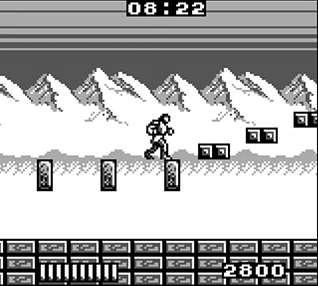 Beware! There are many tough jumps ahead. Take caution upon approaching the collapsible platforms (double-square ▣▣). You'll only have a split-second to jump from them, once your character lands on one. Furthermore, if you strike a candle above them, its contents will drop right through into the pits below... forever lost.
Beware! There are many tough jumps ahead. Take caution upon approaching the collapsible platforms (double-square ▣▣). You'll only have a split-second to jump from them, once your character lands on one. Furthermore, if you strike a candle above them, its contents will drop right through into the pits below... forever lost. Sir Isaac Newton's gravitational laws feel optional, as our nameless hero can make superhuman-sized leaps, but falls to earth like a stone. ("What goes up, must come down"—only seemingly faster.) And gravity's firm hold locks on tight, as this vampire hunter's tread trudges through the game's four stages at an agonizing crawl.
(Meanwhile, candles and solid blocks mysteriously float in mid-air and heavy scythes defy the physical state, as they fly back to the ghoulish Zeldo enemies (also called Nightstalkers), who hurl them—with every intention of whittling down our character's already-scant, 10 bars of Life Line upon their return paths!)
Newton's third law of motion postulates that for every action, there is an equal, but opposite reaction. Obviously, in the Castlevanian universe, this rule is merely a suggestion: as both Simon Belmont and this game's protagonist rebound back from the slightest contact or incidental touch of an opponent. Ironically, the reaction isn't mutual; adversaries seem immovable, unfazed by any bump.
Ideas of inertia are distorted, likewise. The fungi-like Punaguchi (or Spitter in other publications) spew massive fireballs that ricochet through stone corridors and walls at near-unavoidable speed and with full, forward momentum—until they either strike their target, are extinguished by the Mystic Whip (seemingly unique to the whips carried by Simon Belmont) or bounce out of the current screen of play.
Albert Einstein's theories on time and relativity come into question, as this Belmont (???)'s response time lags infuriatingly-slower than the gamer's reaction time and controller inputs. To make things worse, time seems to move in a deliberate slow motion for our heroic player, as "Some Pretty Frightful Dudes"—the phrase that the game booklet gives the game's cast of original enemies—proceed through their existences with a more brisk energy—their singular purpose being to stop him by any means (and not always in a fair manner, programming-wise [More about this later.]).
This will be a good place to delve more into the actual gameplay of this adventure and shine attention on some of its bright spots.
This game stays truer to the action, arcade and platforming vibes of the first Castlevania title. [To learn more about this, click here to read our Castlevania - A Classic In Horror Immortalized (NES) review.]
Our vampire slayer enters this arena with many of the same, inherent abilities and traits as Simon Belmont. He walks, jumps and can even crouch to evade some attacks. There are no staircases to climb like before; so instead, he has to lift himself up ropes to reach heights and cross chasms. (Unfortunately, he cannot swing over treacherous gaps like Pitfall Harry in Pitfall!.)
Our player will need to conquer four stages (fewer than what Simon had to endure in the original game) across a lonesome, two-dimensional world of strange beasts, environmental traps and armored knights with whip in hand.
His Mystic Whip is crucial to his survival. It can tame the various wandering packs of evil that will be standing between himself and the bloodthirsty Count Dracula at game's end. For each enemy struck down, points are added to the Score (another carry-over from Castlevania). He can accumulate points from collecting items dropped from candles and upon defeating each of the Primary Evil bosses found at a stage's end, points are added from the remaining seconds left on the Time Limit.
The score serves a real, serviceable purpose. Once you reach 10,000 points, you will receive an extra life, or the 1 Up On The Count, as the instruction book humorously calls it! Every 20,000 after, you will gain another.
Aside from keeping evil at bay, the Mystic Whip exposes power-ups, too. (Note that unlike the other two Castlevanias, enemies do not drop items in this game, but every candle struck leaves behind an item. (Hmmm... who placed and lit all of these random candles in the first place?))
"Along the way, be sure to light the candles with the tip of your whip." The following list of beneficial items may drop from cracking open the candles (Note that the following terms and descriptors come from the instruction manual.):
- Heart (Partially restores your Life Line.)
- The Flashing Heart (Totally restores your Life Line.)
- "1 Up on the Count" (Gives you an extra life to play with.)
- Cross Of Gold (Makes you invincible for a limited period of time.)
- Crystal (Increases the power of your Mystic Whip.)
- The Flashing Crystal (Calls forth a Primary Evil.)
- The Valuable Coin (Increases your point wealth.)
Many of these items are similar to the item drops in the first Castlevania—only this time, some possess different benefits.
Hearts are, literally, symbolic of life and health in this title (which is especially useful since Castlevania's "Pork Chops" (colloquially called the more accurate names of "turkey" or "wall meat" by fans) are nonexistent in this game).
In the previous titles, hearts performed totally different tasks. In Castlevania, they gave you additional uses of your sub weapons (Daggers, Axes, Fire Bombs (Holy Water), Boomerangs and the Watch). In Castlevania II: Simon's Quest, they were expended on certain special weapons (like the Diamond or Sacred Flame); were used as currency in shops AND helped to increase your Experience Level that earned you more bars of life. [To learn more about these unique features, click here to read our Castlevania II: Simon's Quest - What A Horrible Night To Have A Curse! (NES) review.]
(Note that this game does not have any secondary weapons for attack—a jarring departure from gameplay that is noticeably missing and which would have gone a long way in making this game feel more balanced from a challenge point-of-view... especially because of how crippling the hero's pace is versus enemy attacks and how limited his range is, especially when his Mystic Whip is not fully powered. [More about this shortly.])
Before in the original Castlevania, the Cross triggered a screen-clearing flash that purged the area of all foes. This time out, it provides a few moments of temporary invincibility that allows this hero to pass through enemies with a ghostly flicker untouched. This game's Cross Of Gold, essentially, replaces the prior game's Invisibility Potion.
Since this game was retroactively moved far back on the timeline, this castle is not as lavish as the one in Castlevania. By the time the events occurred in that aged fortress, the Count seemed to have had time to accumulate wealth—Money Bags, Treasure Chests and Crowns seemed so plentiful that they were spilling out of the mortar. In this game, mere Valuable Coins fall from certain candles. Collecting these Valuable Coins may feel more like they weigh down our combatant's pockets, slowing him down even more (if that is possible), but they actually help by adding to the score.
Finding the Crystal twice charges up the Mystic Whip with a stinging swing that can blast off fireballs to burn through Dracula's army. However, if our player gets hit in battle once, the fire ability disappears; if he takes a blow twice, the whip's length and strength diminishes and returns to its weakened, original state.
Finally, the Flashing Crystal only appears at the end of a stage. Once collected, the Primary Evil guardian of that stage will appear as a major boss, standing ready to block your advancement in the game.
Now, let's briefly tour those Stages.
Stage 1 is a great forest that ascends to a cemetery, capped off by a majestic, mountainous backdrop. As was the case in Castlevania, this relatively-safe, opening stage—devoid of bottomless pits or fatal bodies of water—gives the gamer the opportunity to feel out the mechanics and learn basic rules of survival (i.e., whipping candles that aren't really needed for lighting the way, as much as they are for dropping power-ups; discovering what each of the new set of these power-ups provides; climbing ropes that serve as stand-in ladders, in lieu of the stairs, common to the NES' Castlevania titles).
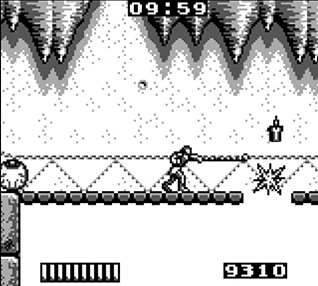 Who knows what monstrous, giant beasts from whence the rolling Big Eyes originate? When struck by whip, these optical orbs explode damaging anything within range—including bridge spans and vampire hunters.
Who knows what monstrous, giant beasts from whence the rolling Big Eyes originate? When struck by whip, these optical orbs explode damaging anything within range—including bridge spans and vampire hunters.It introduces some new things not found in the first, NES title. These include the gratuitous, seemingly generous countdown of time and our hero's paralyzing impediment of extreme slow-motion versus the lethal, real-time speed of enemies, their projectiles and moving parts in the game's architecture (such as levitating platforms, pointed pikes, walls, floors and ceilings).
As our player reaches the forest's end, Golbanz stands as its Primary Evil. His suit of armor deflects your fireballs—if you are fortunate enough to arrive with the ability still intact—while his quick, spear stabs serve as a harbinger of things to come.
(By Stages 3 and 4, the game seems to have an ongoing obsession or fixation on using sharpened spikes to end the hero's progress. It is as if Count Dracula is plotting his revenge by flipping the script on what was commonly seen as the way that vampires were defeated in literature: by using that idea of stakes to impale the threat of the protagonist instead.)
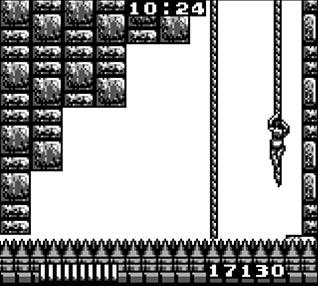
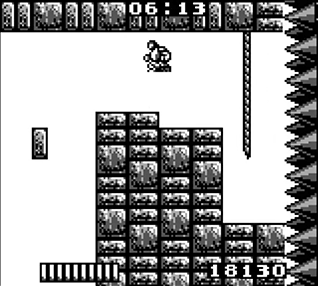 For a game so infamously remembered for its painfully-slow gameplay, it is ironic that Stage 3 plays out as an extended chase. Our hero attempts to outpace the infamous 'Pursuing Wall' (and ceiling... AND floor)!
For a game so infamously remembered for its painfully-slow gameplay, it is ironic that Stage 3 plays out as an extended chase. Our hero attempts to outpace the infamous 'Pursuing Wall' (and ceiling... AND floor)!Stage 2 begins a descent through earthen blocks—deep into a subterranean landscape, across a wide bridge beneath jagged stalactites, where our vampire slayer eventually lands in a large cavern, pockmarked by large burrows. The Under Mole, this stage's Primary Evil, peeks out and hops about helter-skelter, unless our wielder of the whip dispatches each one quickly.
Stage 3 marks a first in the series: the introduction of stagewide, mobile, environmental hazards—specifically, the "Pursuing Wall", as is described in the instruction booklet.
Our heroic avatar can feel the pressure tighten like the turn of a screw, as the ceiling of spikes starts squeezing in. Once he escapes those claustrophobic spaces, he has little time to rest, as a bed of sharpened pikes starts tearing through the floor. A frantic climb (well, as frantic a pace as this slow-grinding game can conjure) ensues.
Once reaching the top of the room, all is not done. With arms feeling heavy and rubbery, the Pursuing Wall comes crushing and puncturing everything in contact, as it forces our fatigued hero to the left over some of the scariest jumps and most terrifying drops in the game, and around tight corners.
(Of course, these wraparound passageways are blocked off by the She Worm, an intentional foe that takes its unhurried time to clear out of the way, as the relentless wall continues its deadly path. When you take into consideration that this game—like the other Castlevanias—retains that violent, bounce-back effect that sends our player airborne whenever he bumps any foe... one realizes with urgency how patience, memorization and evasive actions are essential for survival here.)
Finally, with a little rope burn and a burning set of lungs, Death Bat awaits those few who actually reach his summit. Thankfully, though, his swoops and divebombs come as a welcome relief from the stage's exhaustive, extended pursuit.
Stage 4 opens at the Count's castle, the final destination in this relatively-short adventure. Suits of armor stand at guard along its long entryway. Dracula rolls out everything in a last-ditch effort to thwart a conclusive stance against this Belmont (???): random knights, in rank and file, that spring to life; former Primary Evil bosses being summoned to patrol the halls; Punaguchis/Spitters filling the screen with their Pong-like projectiles that are near impossible to dodge or whip; more horrific jumping; and spike-laden rooms throughout.
Will you be able to guide our hero through the gauntlet of traps, or will you succumb to the drain of your Game Boy's battery life before reaching the hard-to-reach checkpoints and, ultimately, the Count (well... at least, until his next resurrection in the next game)?
Looking back, at its release, Castlevania: The Adventure was a highly-anticipated addition for the early library of the fresh, exciting Game Boy portable console. Kids of all ages could now have the opportunity for the first time ever to play a Castlevania game, while on a road trip or in the backseat of the family car or on the schoolbus.
But, in reality and in practice, the game had its faults.
Because of the newness of the Game Boy, Konami's programmers and developers probably went into this project blind on many aspects for developing their game for the system. There was probably not a long list of established references, notes and pointers to guide the way.
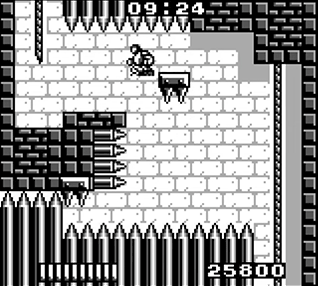 The real-life inspiration for Count Dracula wasn't nicknamed, "Vlad the Impaler", for nothing. Castlevania: The Adventure's Count Dracula wants our hero to get the point: that he is uninvited.
The real-life inspiration for Count Dracula wasn't nicknamed, "Vlad the Impaler", for nothing. Castlevania: The Adventure's Count Dracula wants our hero to get the point: that he is uninvited.In assuming the responsibility and risk of being the first company outside of Nintendo, itself, to represent on the Game Boy, there may have been a lot of pressure to succeed and urgency to get the game out by Christmas (December 25) of 1989 in time for the lucrative, holiday shopping season. (By the game's completion, the production team could probably relate to all of the heart-pumping panic and anxiety of Stage 3's "Pursuing Wall" in real-life.)
Admittedly even under better conditions with more preparation, it would have been difficult to successfully capture the essence and soul of the NES titles and distill those spirits into the restrictive limitations and tinier, visual space of the less powerful Game Boy. The graphics and sound departments made valiant efforts, but the programming side of things strained.
Under the hood of the Game Boy, the game engine seemed as though it was churning somewhat sluggishly... even grinding to a lower speed or gear when multiple sprites, or animated graphics, were in the screen simultaneously. The game mechanics captured the range of movements of Belmonts past, but the inputs felt delayed, filling the gamer with much frustration and fury at times... especially when so many enemies and hazards onscreen attacked and moved at a faster rate than our grounded hero. And the buffer, or bumper zone, surrounding our hero felt meager and—worse yet—inconstant and unreliable in this game; the hit box was surprisingly large and anything, but forgiving and at times, inconsistent around Dracula's "Pretty Frightful Dudes", as well.
(It may be important to add that some of the nuances of the Game Boy's visuals might have affected the programming of this game. The lack of a backlit screen and the possible residual effects of graphic blurring across a liquid crystal display may have shaped decisions with finding a maybe not-so-happy medium—but, a necessary one—in slowing the game's movements to help optimize its visibility and playability overall.)
Castlevania: The Adventure churns along at a snail’s pace, can appear brutally-tough and restrictive and just doesn’t feel too fun to play after the first or hundredth perceived, unfair death. When you factor in all of the punitive measures against this Belmont (???) character (like a shorter Life Line; harsh, bounce-back effects; larger, inconsistent hitboxes; loss of powered-up Mystic Whip after being hit; respawning of enemies, if you inch forward too far in screen and then return; limited, distant checkpoints; no special sub weapons like before (!)), all of the Hearts and unlimited continues cannot fully redeem this title.
Still, this game was one of the earliest releases on the Game Boy in the North American region, so some forgiveness may be deserving or granted for those early programmers and developers and all of their sacrifices.
For all of the disappointment and rancor the title may have engendered from the fanbase over the years, Konami would redeem the game. Ironically, around the game's 20th anniversary in 2009, the Nintendo Wii, through its WiiWare, would receive Castlevania: The Adventure ReBirth. It would prove how truly amazing a totally-reimagined Castlevania: The Adventure could be!
But, for that game to be realized, it took Konami's original attempt to crawl (quite literally with its slow pacing), before that remaster could fly. And crawl, it did: for sadly enough, Castlevania: The Adventure proved to be an exhausting exercise in lag versus patience, and unfortunately, a rare misstep and misadventure in the chronicles of the Castlevania dynasty.
b. jones © Juneteenth 2025
If you like Castlevania: The Adventure, perhaps you would like these titles:
- Castlevania [NES]
- Castlevania II: Simon's Quest [NES]
- Castlevania II: Belmont's Revenge [GAME BOY]
(direct sequel and continuation of Castlevania: The Adventure)
- Castlevania Legends [GAME BOY]
(continuation of Game Boy Castlevania games)
- Castlevania: The Adventure ReBirth [WII - WiiWare]
(excellent, reimagined remake of Castlevania: The Adventure heretofore, only available from the now-defunct Wii eShop as exclusive WiiWare)
- Castlevania III: Dracula's Curse [NES]
...and all sequels, extended games in the franchise, etc. [various]
(direct descendants and continuation of overall story and family tree)
- Ghosts 'N Goblins [NES]
(a spiritual predecessor that helped inspire Castlevania; similar level of rigid control and frustrating difficulty)
- Ghosts 'N Goblins [NES]
- Altered Beast [SEGA MASTER SYSTEM, SEGA GENESIS/MEGA DRIVE, etc.]
(an action title with a similar theme of horror)
(inspiration and direct descendant and continuation of overall story and family tree)
(direct descendant and continuation of overall story and family tree)
FUTURE ADVERTISEMENT PLACEHOLDER.
This area will feature a rotating banner for advertisements.

If you'd like to advertise on our site, please contact us here. Think big, dream bigger!
CONTACT & SOCIAL MEDIA.
We are interested in what our visitors have to say. Please click here to share/e-mail any comments,
suggestions or feedback.
Being the social butterfly that we are, you can like us on Facebook, follow us on Twitter and Pinterest, and watch our video list on YouTube! (Soon, we'll be adding a blog with polls.)
